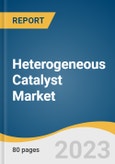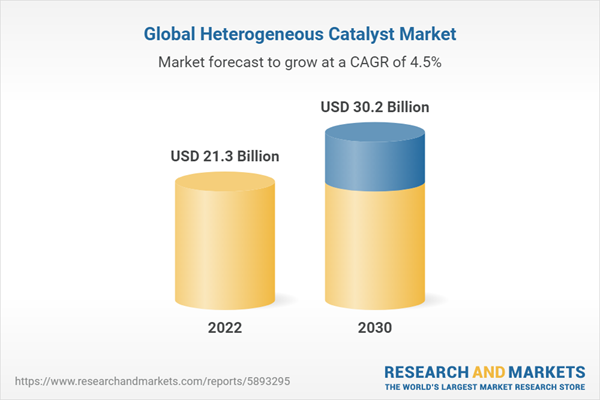The global heterogeneous catalyst market size is expected to reach USD 30.2 billion by 2030. The market is expected to expand at a CAGR of 4.5% from 2023 to 2030. This is attributable to the expansion of chemical and petrochemical industries in emerging economies creating opportunities for the market. Rapid industrialization and growing consumer markets, particularly in countries like China and India, are driving the demand for catalysts to support their expanding manufacturing sectors.
The expansion of chemical and petrochemical industries in these emerging economies is driven by multiple factors. The rising population, urbanization, and increasing middle-class population contribute to the growing demand for consumer goods, automobiles, and infrastructure development. This, in turn, leads to the establishment of new chemical and petrochemical plants, which utilize catalysts for various processes such as synthesis, hydrogenation, oxidation, and more.
Furthermore, government policies and regulations that promote the use of catalysts or impose stricter emission standards can serve as restart factors for the market. For example, environmental regulations that require the use of catalysts to reduce harmful emissions can stimulate demand for catalysts and accelerate their adoption.
However, innovations and technological advancements in catalyst development can act as restart factors for the market. New catalyst formulations or manufacturing techniques that offer improved efficiency, selectivity, and sustainability can attract the attention of industries and drive the demand for catalysts.
The expansion of chemical and petrochemical industries in these emerging economies is driven by multiple factors. The rising population, urbanization, and increasing middle-class population contribute to the growing demand for consumer goods, automobiles, and infrastructure development. This, in turn, leads to the establishment of new chemical and petrochemical plants, which utilize catalysts for various processes such as synthesis, hydrogenation, oxidation, and more.
Furthermore, government policies and regulations that promote the use of catalysts or impose stricter emission standards can serve as restart factors for the market. For example, environmental regulations that require the use of catalysts to reduce harmful emissions can stimulate demand for catalysts and accelerate their adoption.
However, innovations and technological advancements in catalyst development can act as restart factors for the market. New catalyst formulations or manufacturing techniques that offer improved efficiency, selectivity, and sustainability can attract the attention of industries and drive the demand for catalysts.
Heterogeneous Catalyst Market Report Highlights
- The polymer segment emerged as the fastest growing end-use segment with a CAGR of 5.0% from 2023 to 2030; as polymers enable and control and efficient synthesis of various polymers with desired properties
- The zeolite-based segment emerged as the fastest growing product segment with market share of 21.0% from 2023 to 2030; zeolite-based catalysts find extensive applications in the petroleum and petrochemical industries, providing high selectivity and stability in processes like catalytic cracking, isomerization, and alkylation
- Asia Pacific emerged as the fastest growing region with a CAGR of 5.3% from 2023 to 2030 due to high population, land fertility, increased demand for food grains, and effective use of land through fertilizer
- W. R. Grace & Co.-Conn., announced the completion of its acquisition of Rive Technology, Inc., a prominent manufacturer of FCC catalysts. This strategic acquisition encompassed a complete array of service offerings, highly skilled workforce, and cutting-edge technological assets, all of which were seamlessly integrated into the operational framework of W.R. Grace & Co.-Conn
- Market participants are dedicated to intensively optimizing and managing the efficiency of their supply chains. Their objective is to enhance operational efficiency, increase productivity, reduce lead time, and effectively address sourcing needs. This strategy enables them to remain competitive in the market and effectively contend with other industry players
Table of Contents
Chapter 1 Methodology and Scope
Chapter 2 Executive Summary
Chapter 3 Heterogeneous Catalyst: Market Variables, Trends & Scope
Chapter 4 Heterogeneous Catalyst Market: Product Estimates & Trend Analysis
Chapter 5 Heterogeneous Catalyst Market: Application Estimates & Trend Analysis
Chapter 6 Heterogeneous Catalyst Market: Regional Estimates & Trend Analysis
Chapter 7 Competitive Landscape
List of Tables
List of Figures
Companies Mentioned
- Albemarle Corporation
- Haldor Topsoe A/S
- BASF SE
- Evonik Industries AG
- LyondellBasell Industries Holdings B.V.
- Arkema
- The Dow Chemical Company
- Haldor Topsoe A/S
- W. R. Grace & Co.-Conn.
- Johnson Matthey
- Axens
- Honeywell UOP
- Zeolyst International
- Clariant
- Umicore
- Exxon Mobil Corporation
Methodology

LOADING...
Table Information
| Report Attribute | Details |
|---|---|
| No. of Pages | 80 |
| Published | September 2023 |
| Forecast Period | 2022 - 2030 |
| Estimated Market Value ( USD | $ 21.3 Billion |
| Forecasted Market Value ( USD | $ 30.2 Billion |
| Compound Annual Growth Rate | 4.5% |
| Regions Covered | Global |
| No. of Companies Mentioned | 16 |









